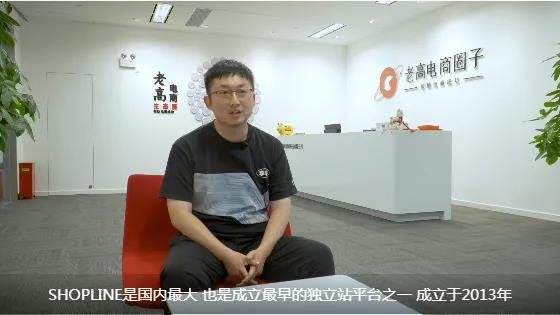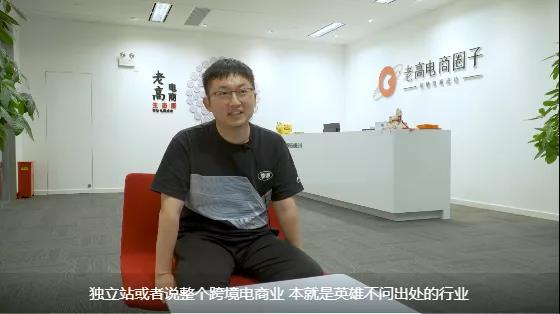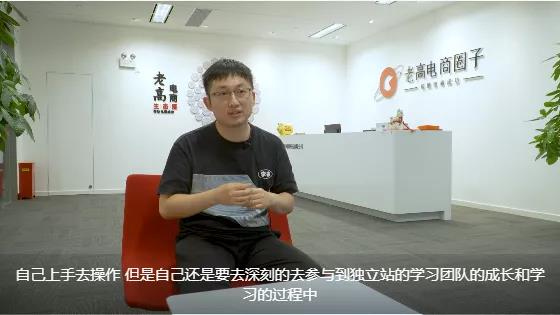Not long ago, the Shenzhen Bureau of Commerce vigorously advocated cross-border sellers to develop independent websites and gave them a reward of up to 3 million yuan. The concept of independent websites has been pushed to the forefront . Independent websites are really new things for our domestic sellers. Many people are curious about them but dare not try them easily.
For this purpose, we invited Guo Xiaoqiao, general manager of SHOPLINE East China to answer questions and answer questions for sellers who want to go overseas or have already gone overseas!
Q: Mr. Guo, can you briefly introduce the SHOPLINE platform?
A:
OK, SHOPLINE was established in Hong Kong, China in 2013. It is one of the largest and earliest independent station platforms in China. It was originally developed in Hong Kong, Taiwan and Southeast Asia, with good accumulation. It currently has a very good market development in mainland China, serving many mainland companies to go overseas.

SHOPLINE is Google's first official partner in the field of e-commerce in Greater China , and is also Facebook's earlier official strategic partner in China.
Q: When did SHOPLINE develop in the mainland?
A:
It should be 2019. During the 2013-18 period, it was mainly in Hong Kong, Taiwan and Southeast Asia. Many people have a misunderstanding, saying that although we started in Hong Kong, Taiwan, many people in the industry think that we are mainly in Southeast Asia. In fact, most of our active outlets are in Europe and the United States, among which developed countries in North America and Western Europe account for nearly 50%.
Q: How many customers does SHOPLINE have in total?
A:
There are 270,000 customers worldwide.
Q: Can you introduce some of the current situation of SHOPLINE merchants in the mainland Chinese market?
A: It is roughly divided into 4 categories:
① Sellers of traditional e-commerce platforms: There have been major changes from the second half of last year to this year. Many sellers and companies of traditional e-commerce platforms will expand their business lines, which may not be transformed, but will at least deploy independent websites at the same time. Therefore, sellers of traditional e-commerce platforms mainly based on Amazon are our service group;
② Brand owners: We will also serve some domestic brand owners. Whether they are old or emerging brands, their overseas travel will also be our attention;
③ Industrial and trade enterprises: In the past, they were traditional trade or overseas big-name OEM enterprises, and such enterprises belong to our support or service;
④ Seller of the Ashes: Independent Station, it may have been known to the public in nearly a year in China, but internationally, it is an industry that has existed for a long time, and can basically be traced to 10 years ago. In fact, there are a group of sellers of purely independent websites in China, which is also the object of our service.
Q: What are the more popular and highly active categories of the SHOPLINE platform?
A:
If we absolutely say that, we can answer this question from two perspectives, such as the domestic major categories: clothing, digital accessories, home, outdoor, makeup, etc. No matter which industries it is, whether it is traditional e-commerce or independent websites, these major categories are still very large in size.
From another perspective, we have served many other categories, which are not necessarily toC. For example, niche categories such as rock crushers, welding machines, forklifts, and even cycling equipment are also very active.
Q: How to see the future trends of e-commerce in the next 5-10 years?
A:
Whether it is e-commerce or cross-border e-commerce, especially cross-border e-commerce, it will always exist and continue to be popular. Because cross-border has existed for hundreds of years, it is no exaggeration to say that it has existed for thousands of years. The scale will be very, very large, and the industry will only get better and better.

In the next 5-10 years, even if policy changes and phased challenges are made, in many markets except for the European and American markets, even with the support of the epidemic last year, the e-commerce penetration rate of these markets is still very low. For example, the penetration rate of e-commerce in Southeast Asia has not reached 10%, and its room for growth is very huge.
This year, the U.S. e-commerce accounts for 30-35% of its total e-commerce retail sales. Of course, this data may not be particularly accurate, and the penetration rate ratio with China is still not that high, but it is already good compared to the U.S. 10-15% in 2019.
There are also markets such as Latin America and the Middle East, which have great potential for future growth. These are all macro environments, and with the accumulation of domestic talents and supply chains, the dividends of the entire cross-border e-commerce will continue in the future.
Q: The SHOPLINE platform is relatively active in Europe and the United States, so what is its e-commerce penetration rate?
A:
Different countries are different. In my impression, except for China, several other top countries include the United States, Canada, the United Kingdom and South Korea. Before the epidemic came at the end of 2019, the penetration rate of e-commerce was basically around 10-15%, while China was already far ahead at that time, reaching between 35-40%.
The subsequent outbreak of the epidemic has greatly accelerated the penetration rate of e-commerce in various countries, especially many groups that have not passed e-commerce consumption before, have converted them into customers during the epidemic. This has a positive and long-term impact on cross-border e-commerce in the post-epidemic era.
Q: Is it still too late to do cross-border e-commerce now?
A:
This question has a certain degree of continuity with the question just now. First, answer the first question, because the industry will definitely continue to grow, so I think it is always time. However, the industry is constantly developing and the business methods need to be iterated continuously. Sellers who want to enter the cross-border e-commerce industry must constantly change and improve their own operational capabilities.

For example, for now, independent websites are new for many domestic sellers, although they are a mature ecosystem for the world. Therefore, no matter whether you are traditional e-commerce or traditional trade, there will be about three to five months of learning period when you switch to independent websites. After passing the learning threshold, the value and energy that independent websites can bring to you is huge.
Q: So if I am a domestic e-commerce seller and want to switch to cross-border e-commerce, what content should I learn? What preparations should be made psychologically?
A:
① Whether it is platform e-commerce or traditional foreign trade, it is necessary to have a dedicated team to operate an independent website. There can be few teams, only two or three people, but it must be a team dedicated to independent websites. It cannot be allowed to build a platform, but also an independent website, because the operation details and methods of the two are different. Such a team is equivalent to the seed team in your future enterprise, so we first suggest that we need a team that focuses on operating independent stations;
② There is a big difference between independent websites and platforms, which is traffic gameplay. The platform is a logic that distributes traffic based on users' searches in different stores. In contrast, independent websites are a process of actively recommending products to potential buyers, so the overall traffic is completely different.
Operators should realize that the operation methods of independent website traffic are different, and they will spend a certain amount of time to accumulate learning, including the gameplay logic of mainstream media such as Facebook, Google, and tiktok.
③ The traffic attributes of independent websites are different from those of traditional e-commerce platforms. They have their own set of product selection logic and will have many similarities compared to Amazon. However, the difference is that products that are easy to sell on Amazon may not be easy to sell on independent websites. Products that are not bad on traditional platforms may be particularly good to sell on independent websites.
This is determined by the traffic attributes of independent websites. Of course, there are factors such as whether the product itself can solve the user's pain points. Therefore, we recommend that sellers realize that the product selection skills will be different from the platform when building independent websites.
④ There are two larger schools of independent websites. One is mainly selling goods (80%) and the other is mainly building brands (20%), or it has not reached the level of brand building, but focuses on a certain sub-category and product-powered products, not relying on massive distribution of goods to create hot products.
Amazon's total transaction volume of self-operated + third-party last year reached US$490 billion. Although there is no special official data on the entire independent website, we conservatively estimate that the total transaction volume of independent website reached US$200 billion last year, which is actually the same as traditional platforms. Moreover, the entire industry of independent websites has developed much faster than traditional platforms, and the annual growth rate is far greater than that of e-commerce platforms.
In the 200 billion US dollar market, no matter whether the seller chooses to sell goods or build a brand, there is no right or wrong in the future. We sellers need to find this path that suits our team.
We believe that roads like selling goods and laying goods will exist for a long time, because its core essence is to sell popular and trendy products. The nature of this type of business determines that this operating model will exist for a long time.
Of course, it is undeniable that many very dazzling companies have created brands through independent websites, and can achieve sales of billions of dollars a year.
Therefore, domestic companies that want to go overseas can choose a path that suits them based on the genes of their teams, and these two paths are not exclusive to each other and can also operate intersectly.
Q: Which kind of merchant is suitable for independent websites?
A:
The first type is an enterprise that undoubtedly has its own supply chain accumulation and strength. For such companies, we do not recommend that they switch tracks and pursue popular products. They should do the supply chain and sub-categories they know, and also pay attention to similar overseas products, product matching, product strength and user needs.
The second category is a team that focuses on product selection and traffic operations and is more focused on operations;
The third category is a team that has a deep understanding of overseas culture and customers. Of course, it does not mean that he understands all the needs of overseas users, but that he has a deep insight into a certain pain point and demand point of overseas users, and at the same time, he will narrate the story of the brand and product in a way that is easy for overseas users to accept.
The fourth category is traditional domestic brand owners. They themselves have the brand positioning, planning, and management, and their supply chain are also solid, and may lack some experience in cross-border e-commerce operations. If this shortcoming is made up, they can do cross-border e-commerce or independent websites.
There may be other types of merchants, because the entire cross-border e-commerce industry is a place where heroes are blooming regardless of their origin.
Q: What are some good suggestions for cross-border sellers?
A:
Independent websites are emerging things for domestic sellers, and there will be a period of learning. Any company that wants to build an independent website must use a focused team.
At the same time, it is strongly recommended that the core personnel of the enterprise, including the number one position of the enterprise, should deeply participate in the learning of independent stations, because after the independent station is finally made, it will become the core competitiveness of the enterprise, and the organizational structure, KPI assessment, etc. of the team must be planned by the senior management of the enterprise.
Q: How do you view the Laogao e-commerce circle?
A:
In my impression, Laogao's e-commerce circle is not only the cross-border e-commerce field, but especially the domestic e-commerce field. It should be regarded as the top community in China, but also the oldest. For example, in the Tmall and Taobao field, Laogao's e-commerce circle has accompanied countless e-commerce people to grow up, which is really a witness to the growth of the industry.
Nowadays, for every practitioner, he will face the turning point in the industry in the next 5-10 years, or in other words, the situation where the industry will go to a higher level. We are looking forward to having closer cooperation with Laogao E-commerce Club and Laogao Cross-border E-commerce Club to serve cross-border e-commerce overseas.









 EN
EN CN
CN
